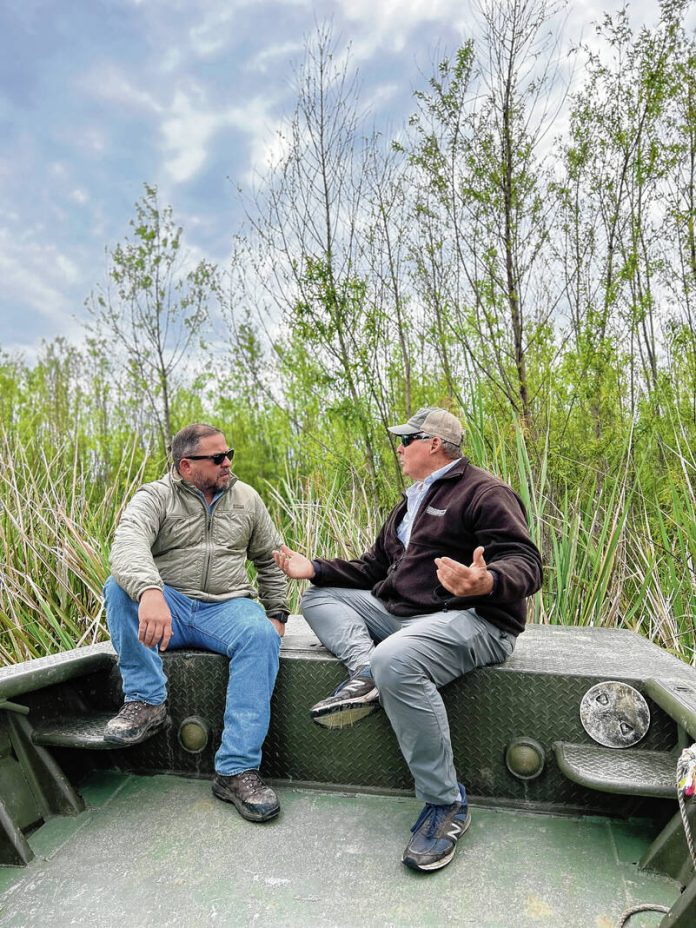
The author learns about the health of the marsh from lifelong resident and owner of CajunFishing Adventures, Captain Ryan Lambert.
Submitted photo
A recent monumental road trip took me from Brunswick, Missouri, to the terminus of the Mississippi River just south of Venice, Louisiana. The purpose of the trip was to gain a far better understanding of the dead zone in the Gulf of Mexico, and how nutrients, like nitrogen and phosphorous, running off of farm fields in the Heartland are changing the complexity of life for our neighbors down south.
The landscape of the Missouri River Watershed has changed dramatically since Lewis and Clark encountered it in 1804. Both the Grand and the Missouri rivers are now constrained by levees and the buffering prairies are gone. The water rushing down the modern shipping canal versions of our great rivers carries with them all the nutrients that erode or wash into our rivers, creeks and streams. Depositing unwanted nitrogen and phosphorous in the Gulf of Mexico, thus resulting in a hypoxic dead zone zone.
Our second stop along the way was in Columbia, Missouri, where we met up with Steve Schnarr from River Relief to learn about how his organization works. Reiver Relief exists to connect people to the Missouri River. Teams of volunteers clean trash and debris from the river. Schnarr describes clean, fresh water as modern-day gold. As this most important natural resource becomes more and more rare, he predicts another gold rush of sorts is likely to ensue.
Armed with a better scientific understanding of nutrients in our waterways, we take a turn to the south and pass through Jefferson City. Missouri’s scenic state capital is located right on the river. After admiring the beautiful Capital building, we headed to Hermann to explore why this river town continues to thrive while so many around it slowly disappear.
Hermann, Missouri, is home to a robust wine industry. When settlers arrived in the region, they expected to find fields ready for row crops. Instead, they found hills too steep for a plow. They began growing grapes, and Missouri wine was born. Today, the beautiful river hamlet is thriving on tourism. Hotels and shops teem with people who come to relax and enjoy the grapes in the Missouri River Valley. It’s an example of how a city or region can embrace the hand they’ve been dealt, and play it to perfection.
As we roll through the Bootheel of Southeast Missouri, we stop in Cape Girardeau to fuel up on some Cajun food and fill the truck with gas. We’re on our way to Cairo, Illinois, where we’ll learn about the demise of a once bustling river town.
We met Monica, a wonderful woman who runs the library and serves as the city’s unofficial historian. Time has clearly not been kind to Cairo. For her and all others who hold this little river town in their hearts, one can only hope for new means of economic growth to emerge and breathe life back into the community. Perhaps those gains will come from new climate smart commodities in agriculture.
In each community we visited, signs of economic decay are evident. It saddens me to think we are leaving behind the people of these little cities and towns, in lieu of cheaper, faster, easier gratification. America was built on the back of agriculture. And we still lean on the industry as a major contributor to our national GDP. If we aim to turn around the decline of our rural economy and keep alive the beauty of small-town living, then we must to find new and better ways to produce crops and livestock in this country. Thankfully, new horizons are emerging and giving us hope for a sustainable future in rural America.
Long before we had an interstate system and jet airplanes to rocketed us around the world, rivers were the major mode of transportation. None more critical to the expansion of our country, than the Mississippi. We stopped in Vicksburg to learn how a strategic move along the river during the Civil War helped ensure the future of our nation.
Waterfowl hunting is a passion of many residents of the Mississippi River Region. Each fall, hunters represent a critical economic stimulus to cities like Tunica, Vicksburg and Natchez. Waterfowl demand clean water and healthy riparian ecosystems. If we hope for good waterfowl hunting throughout the Mississippi Flyway, we must protect our water.
We went to LSU to visit with hypoxia experts, Professor Nancy N. Rabalais and Doug Daigle, a research associate in the Department of Oceanography & Coastal Sciences. They made it very clear that they believe agriculture in the heartland is responsible for the hypoxia issue in the Gulf of Mexico.
They explained that dead zones occurs when oxygen in the water drops below levels necessary to sustain life. This means fish and plants cannot survive, leaving an area without void of living organisms — a dead zone. And the one in the gulf is the second largest in the world.
Overall, the trip was highly educational about how cover crops and restored prairie strips can protect our water. Stopping nutrients from entering our water in the first place is key to stopping them from reaching the Gulf. To learn much more about this issue, and to watch a two part video series on this journey, check out my new media venture Prairie Prophets at www.prairieprophets.com
It’s quite a journey for a rain drop that fell on soil in the upper Midwest to travel all the way to the ocean. We’re closing that loop and coming to understand how best to ensure the water our rivers are delivering to the world is as pure as possible.
See you down the trail…
Brandon Butler writes an outdoors column for The Republic. Send comments to [email protected]. For more Driftwood Outdoors, check out the podcast on www.driftwoodoutdoors.com or anywhere podcasts are streamed.




